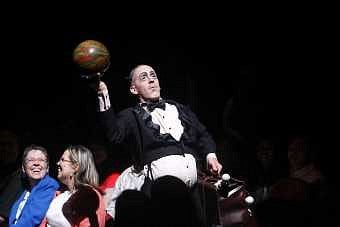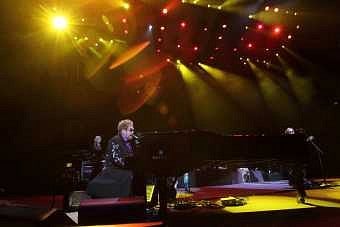The lights go down inside Matthew Knight Arena in that singular moment of anticipation just before the concert begins—the roar of the crowd reaches a crescendo, an electric storm of excitement howling in the cavernous space.
Watching from a perch somewhere in the shadows, Mike Duncan ’80 feels his own kind of charge as he surveys the buzzing mass, sometimes 12,000 strong.
“Somebody comes out on stage and you see the whole building stand up and start clapping and just explode. The fun part is knowing that you were involved in making that happen,” says Duncan, senior associate athletic director for facilities, events, and operations.
His title is a mouthful, but as ringmaster for the University’s biggest indoor stage, Duncan’s primary responsibility—and the thing he most enjoys—is clear: “Bringing great events to town.”
Since opening in January 2011 as the replacement for historic McArthur Court, the gleaming, metal- and glass-clad Matthew Knight Arena has hosted an impressive roster of major-league entertainment events including rock icon Elton John, gravity-taunting acrobatic troupe Cirque du Soleil, country music chart-toppers Brad Paisley and Lady Antebellum, the “Nike Clash of the Champions” tennis exhibition, and adrenaline-pumping displays put on by World Wrestling Entertainment and the Professional Bull Riders series.

“We did everything down there, about 200 events a year. Concerts from the Rolling Stones to U2 to Garth Brooks, almost every major artist you can think of,” Duncan says. “We also hosted the NCAA basketball tournament, the women’s volleyball final four, some great NBA playoff games, governors’ inaugurations, all kinds of things.”
Though plans for Matthew Knight Arena don’t call for quite that much activity, expect a similar breadth of events extending far beyond UO basketball and volleyball games. And the arena, which seats 12,369 for sports, can morph to meet most any need. Banks of seats retract to increase floor space; a giant grid of steel rigging overhead supports almost any conceivable equipment load; for smaller crowds, curtains hide empty upper-level tiers to create a more intimate space of about 5,500 seats; and subterranean loading docks allow big rigs access to the main floor for fast event setup and breakdown.
“We can configure it many different ways according to the event,” says Duncan, who joined the UO intercollegiate athletics department in October 2008 and consulted on some design issues before arena construction began in February 2009.
Nonsports events were a long-term priority from the earliest days of planning for the new arena, but the potential financial impact of these events has proved to be a moving target.
“Originally, we were looking at doing around forty [non-UO sports] events a year. We were short of that the first year, and I expect we’re going to be short of it this year, too,” Duncan admits.
In fact, the athletics department announced in February that it had trimmed its initial ticket revenue projections (set in 2010), including a 15 percent reduction for men’s and 25 percent cut for women’s basketball, and more than 30 percent less for concerts and other outside events.
Basketball game attendance was lower than expected, especially early in the first full season of play at the new arena, when it appeared both teams were in “rebuilding” mode. Real and perceived parking and transportation challenges in the arena district may have kept away some people. And, ironically, outstanding back-to-back seasons for the UO football team might have curbed the emotional and financial investment fans were willing to make in basketball. This plus the ongoing weak economy.
Despite the shortfall, Duncan says, “I think everybody was happy with the way things went the first year. I would like to have seen more concerts, and we will as the building matures and as promoters and agents see that people are buying tickets in Eugene.”

Such hits give Duncan a much-needed sales tool as he urges tour decision-makers to seriously consider Eugene. Even with the appeal of Matthew Knight Arena (“I don’t think there’s another university building in the country that can match it,” he says), his booking work was easier at ARCO Arena.
“Tours were going to play Sacramento regardless and they were calling me,” he explains. “In Eugene, it’s a much smaller market and a new building, and everyone doesn’t know we’re here yet. I’m making a lot more phone calls than I have in the past.”
Still, Duncan says he is thrilled to manage his alma mater’s showpiece facility. “I had always hoped to get back to Eugene at some point, so when there was a chance to be a part of building a great new arena here, I couldn’t pass it up.”
Born and raised in Sacramento, California, Duncan earned his undergraduate degree in public relations at Oregon, where he also worked three years as an intern in the sports information office. After graduation, he returned to his hometown and was hired as sports information director at California State University, Sacramento. This job helped springboard him into a community relations position with the Kings when the NBA franchise moved there from Kansas City in 1985. The Kings relocated to the newly built ARCO Arena in 1988 and Duncan joined the facility management side of the business—a role that prepared him for almost anything.
He recalls the challenge of dealing with a Billy Graham crusade, which drew 53,000 inside and outside the 17,000-seat building. And a malfunctioning hockey rink that required an all-nighter of jackhammers and all-hands effort to get the ice frozen and functioning before a San Jose Sharks game. And the famed monster truck Grave Digger smashing into a section of the arena’s retracted seats, requiring another herculean effort to restore the seats to working order before tipoff at a Kings game the next day.
While so far he has avoided such drama at the UO, Duncan has responded to logistical challenges at Knight Arena.
The Oregon men’s basketball team unexpectedly made the College Basketball Invitational last year, and then kept winning, which set up a championship game at home against Creighton—at a time Duncan had reserved to “load in” a bull-riding event.
“So once the basketball game was over we started taking up the floor and retracting the seats, and then brought dirt in all through the night,” Duncan says. “That was tight.”

Pleased with the arena’s performance through everything so far, Duncan now is focused on booking a greater mix of concerts.
“I’ll go after anything that will sell tickets,” he says.
The current Van Halen reunion tour would be a candidate, but such high-profile arena tours typically play only the biggest, most lucrative venues. Van Halen’s initial 2012 tour lineup included about forty shows with just one Northwest stop, the 21,000-seat Tacoma Dome.
“If there’s a tour that’s going to play thirty or forty dates, it’s probably not going to get to Eugene,” Duncan explains. “But there are a lot of acts that will play eighty to 100 dates and are looking for 6,000 to 10,000 seats; those are the kind we can bring in.”
After managing 600 to 700 concerts during his years in Sacramento, Duncan says, “There aren’t many shows I haven’t had the chance to see.” But he’ll still feel the charge the next time the lights dim and Matthew Knight Arena starts to rock.
—By Joel Gorthy ’98


